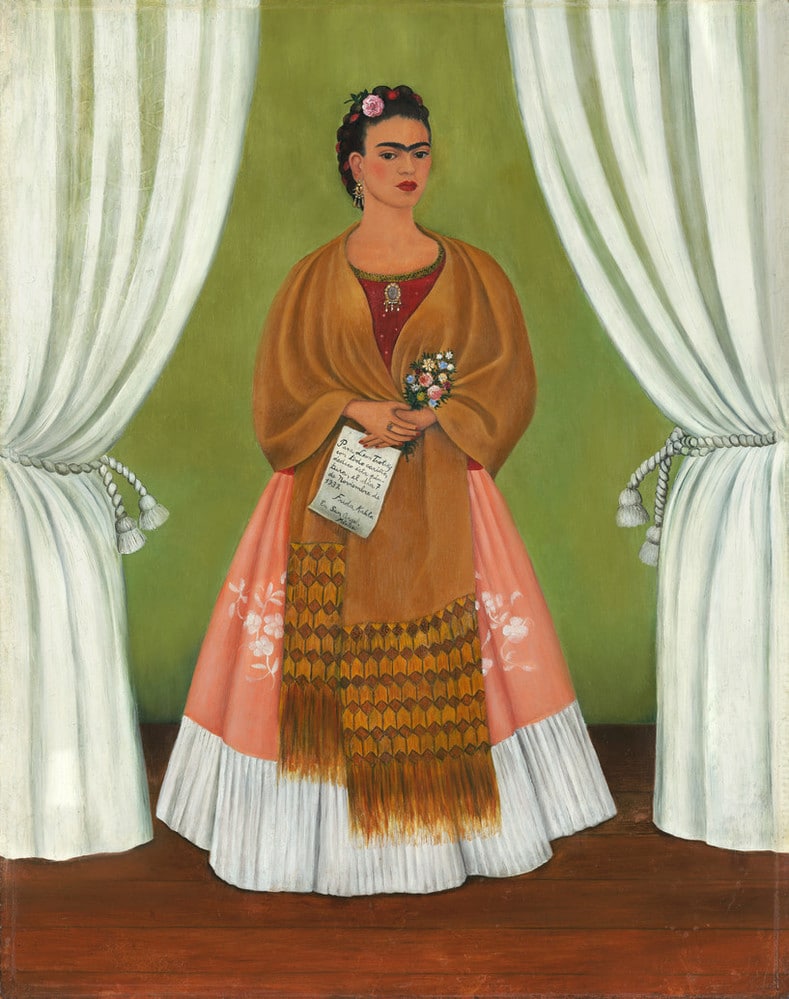Frida Kahlo’s Self-portrait dedicated to Leon Trotsky (1937)
Frida Kahlo’s work has always been more than just depicting herself globally because her paintings are a way for her to translate her memories, culture, or experiences visually. Kahlo’s work is also a way of expressing especially the complex ideas running through her mind. Kahlo’s self-portraits are especially laden with rich symbolism hidden in details that reveal a deep insight into the painter. In the portrait dedicated to Leon Trotsky (1937), Kahlo provides a self-flattering painting she made as a gift for Trotsky, a Russian revolutionary leader shortly after arriving in Mexico following his expulsion from Russia. The portrait was a commemoration of a brief affair between Kahlo and Trotsky. However, the self-portrait is more than a dedication since a comprehension examination uncovers symbolism in the artist’s context, time, and place.
Analysis
In this painting, a front-facing subject, Frida holds a bouquet and a letter in her hands. Against a green background, brilliant white curtains flank one another. Kahlo’s frontal position allows her to confront the viewer’s gaze from the canvas directly. Kahlo’s bold eyebrows hold the emphasis on her face. The painting also reveals an elegantly dressed subject wearing elements of Mexican Zapotec dress derived from Tehuanas. The typical style of the Tehuanas comprises of a floral patterned tunic (huipil), a skirt trimmed with starched race, gold and silver ornaments, and bright ribbons decorated with fresh or fake flowers.

Kahlo borrows heavily from this culture and presents herself elegantly dressed in delicate gold jewelry, a shawl, and embroidered skirt, emphasizing her culture. The dedication to Trotsky, although written in Spanish reads, “For Leon Trotsky with all my love, this portrait is dedicated on 7 of November 1937. Frida Kahlo. In San Ángel, Mexico.” The portrait’s compositional elements underscore the focus on the subject, which reflects a similar compositional style common in vernacular devotional paintings of the Virgin of Guadalupe known as retables. The compositional technique elevates the painting into a goddess-like devotion to the theme of love.
A surrealist artist, Kahlo incorporates her heritage and clothing style into this portrait as in many of her other paintings. Her compositions express feelings such as strength, loss, and pain through various subjects, especially in her self-portraits. Kahlo uses oil painting which is the most popular medium of Masonite boards and oil paint she uses in other paintings. The powder is mixed with the pigments in oil and allowed to dry slowly. Like in her other self-portraits, Kahlo uses color and clothing as her main techniques to depict an eye-catching and unusual self-portrait with double figures.
Commentators observe that the technique conveys the painter’s inner struggle to understand and fight what she is as an individual. Kahlo uses visual art to express her feelings to the viewer as she did in the broken column. Kahlo’s design discipline is built upon space, texture, color, shape, and line that combine to make up unity, variety, balance, emphasis, rhythm, and design principles. However, color is the most aspect Kahlo uses in the self-portrait to highlight her culture, feelings, and subject matter. The artist uses bright shades of white, red, green, brown, and peach. The colors provide an authentic Mexican feel and are also used on the floor, furniture, and accent pieces.
Historical Context
Different types of visual arts have developed in Mexico over the years. According to studies, the development of art follows Mexico’s history briefly and is divided into the pre-Hispanic Mesoamerica period, the colonial era, and the period following the Mexican War of Independence. The artist’s cultural attire alludes to a Mexican movement comprising of artists during the revolutionary decade who sought the return to the country’s folk traditions and roots as they rejected European influence. The movement’s influence is also prevalent in the composition of the painting where Kahlo is standing, which is reflective of Mexican vernacular paintings (retables) Kahlo collected. The retables are devotional images of the saints or the Virgin Mary painted on tins.
The development of Mexican national identity became prominent in art in the 19th century, which was also the fluorescence of contemporary Mexican art, especially between 1910 and 1920 after the Mexican Revolution. After independence, the European style heavily influenced Mexican art despite some indigenous themes in major artworks. Artists during this period, including Kahlo, her husband Diego Rivera, José Clemente, Fernando Leal, and David Alfaro Siqueiros in the first half of the 20th century, began distinguishing their work from the Spanish Colonial arts. The self-portrait is, therefore among the liberal Mexican artistic works with a preference for indigenous elements to create visual narratives for Mexican culture and history. The impact and influence of this movement were so strong that it affected newly invented technology like cinema and still photography. The movement also promoted popular crafts and arts as part of Mexico’s identity. Kahlo’s self-portrait exemplifies how Mexican art broke away from the muralist to integrate more elements from the country’s indigenous culture.
In conclusion, The Self-portrait dedicated to Leon Trotsky shows how the artist rejects the muralist style and adopts one that promotes Mexican culture and history. The work features intense personal work about herself and subject matters of politics, sexuality, and culture. Like most artists of her time, Kahlo’s painting is liberal Mexican artistic work that preferred indigenous elements for visual narratives over Spanish colonial arts that had dominated arts for a long time.
